Experimental Evaluation of Ceramic Coatings for Die Protection in Low-Pressure Die-Casting Process
Abstract
1. Introduction
2. Materials and Methods
2.1. Substrates and Coatings
2.2. Preparation of the Coatings and Painting Process
- Manufacture of the 100 mm × 100 mm × 5 mm steel samples and pre-treatment of the surface by different finishing processes: grinding, polishing, or shot blating.
- Cleaning of the surface of the samples with ether and acetone in an ultrasonic bath for 5 min, respectively. After the ultrasonic bath, the surface of the samples was rubbed with a paper wetted in acetone to remove any remaining dust, dirt, lubricant, etc., and air-dried at room temperature.
- Preparation of the water–paint mixture in a 1:4 ratio, which was in the middle of the recommended mixing ratio range of the manufacturer (1:3–1:5). The mixture was continuously stirred to avoid deposition of the refractory particles ensuring a homogeneous mix.
- Application of the coating by spray painting with an SG3041 Optima 601 (Motor Guard Corporation, California, USA) or Perfekt 4 (Krautzberger GmbH, Germany) spray gun:
- The gun was gravity filled with 0.5 L of the paint mixture. The nozzle of the gun was 1.8 mm, and the air pressure was fixed at 4–4.5 bar, with the flux and spraying angle adequately selected by the user, to have a continuous flux of the painting.
- Prior to the application of the coatings, the samples were heated above 250 °C to be in the range of 200–220 °C when the coating was applied to ensure a similar evaporation grade of the water in the paint mixture for all the samples. For this, eight samples were put together in a plate that was inserted in a HIGHTEMP 2001406 (JP Selecta, Spain) oven to ensure a higher thermal inertia and a better control of the painting process. The temperature on the samples surface was controlled with a type K thermocouple to ensure they were at the desired temperature range during the painting process.
- Once the samples were heated, they were extracted from the oven and painted over the plate, with an application distance of 200–300 mm making successive passes of the gun under continuous and relatively fast movements applying several thin paint layers.
- Curing of the coatings in the oven at 400 °C for 60 min.
- Determination of the thickness of the coatings for every sample and characterization of the coatings by the tests described in the following sections.
2.3. Coating Characterization
2.4. Wear Resistance Evaluation in Falling Abrasive Test
- From 0 to 1000 g in 100 g steps;
- From 1000 to 3000 g in 200 g steps;
- From 3000 to 7000 g in 200 g steps;
- From 7000 g until the end of the test in 1000 g steps.
2.5. Wear Resistance Evaluation by Taber Abrasion Test
3. Results and Discussion
3.1. Application of the Coatings, Problems Solved, and Lessons Learned
- A proper cleaning process of the steel surface prior to coating is critical. Apart from cleaning the sample with ether and acetone in the ultrasonic bath, it was necessary to rub the surface with a paper wet with acetone to remove any remainder of dirt to ensure proper coating bonding. This step was found to be critical for improving the adhesion of the primer to the metal surface, which was confirmed by the results obtained with the pull-off adhesion test above the specification limits.
- After cleaning and removing the coatings in the ultrasonic bath with water and soap, the samples could be successfully recoated, with good adhesion to the substrate.
- Even if shot blasting is usually related with improvement in the adhesion of coatings to the metal surface, no big differences were observed in the results obtained in the preliminary trials of this work with respect to the results obtained for the ground and polished samples. In all cases, the results of the pull-off test were above the critical value with no detachment of the coating’s first layer.
- Bigger refractory particles in size resulted in a more complicated application of the coatings. In order to avoid the particles getting stuck in the gun, an appropriate regulation of air pressure, media flux, and opening angle were optimized for the gun with 1.8 mm orifice diameter, always ensuring a regularly stirred mixture of the paint during the application step.
- The final coating thickness achieved varied depending on the coating. In some cases, the minimum thicknesses of 150 µm was easily achieved. In the case where the final thickness was below this value, more paint layers were applied to reach the minimum target thickness. The final mean thickness of the coatings ranged from 150 up to 210 µm. Furthermore, the thickness of a coating in the same sample was found to have a significant variation, around ±15%.
- The temperature of the sample was found to be critical for an adequate application of the coatings and should be within 180–220 °C. Temperatures above 220 °C resulted in an increase in the porosity degree of the coatings, which is not desirable in terms of consistency and wear resistance.
- The total thickness of the primer was determined from the wear tests, with the Positector device once the coating (white, yellow, etc.) was worn out and the primer (red) was exposed and easily identified. In all cases, the primer applied was around the target 50 µm.
3.2. Coating Characterization
3.3. Influence of the Surface Pre-Treatment and Primer Layer on the Adhesion and Wear Behaviour of the Coatings
3.4. Influence of Steel Temperature on the Painting Process and Coating Thickness on the Adhesion and Wear Behaviour
3.5. Coating Wear Resistance Results on Falling Abrasive Test
3.6. Coating Wear Resistance Results on Taber Abrasion Test
3.7. Selection of the Most Promising Coatings Based on the Adhesion and Wear Tests
- Roughness: Ratio between each coating mean roughness value and the coating with maximum roughness (A1—46.3 µm).
- Adherence: Ratio between each coating adhesion force mean value and the highest value registered for all the coatings (B3—16 MPa).
- Falling abrasion: Ratio between each coating abrasion resistance and the highest value registered for all the coatings (B3—100.72 gr/µm)
- Taber abrasion: Ratio between each coating abrasion resistance and the highest value registered for all the coatings (B3—70.7 cycles/µm)
- Conductivity: Ratio between each coating conductivity and the highest value registered for all the coatings (C1-1760 Wm−2 K−1)
4. Conclusions
- The surface preparation and especially the cleanliness of the moulds is vital to achieve adequate adhesion of the coatings.
- Higher refractory particle size leads to higher roughness affecting the surface topography of the cast part but enhance the fluidity through a slower solidification of the aluminium to meet target filing strategies. Furthermore, it has been observed that the wear extent also increases with higher particle sizes. Therefore, the selection of particle size should be made considering the different parts of the moulds, cast geometries, and surface finishing requirements, employing even a combination of sizes to meet the requisites.
- In the case of average insulation coatings, B3 presented the best results in terms of surface finishing, adhesion, and wear resistance. No significant improvement on the coating performance was observed with the extra binder employed for B2 in comparison with B1, just a slight increase in adhesion.
- In the case of high insulation capacity coatings, A2 presented higher wear resistance with much lower surface roughness compared to A1, for the same insulating degree, but lower adherence. Similar results were obtained for D1 coating, which possesses lower insulation capacity. The war resistance of all these coatings with coarser gran size was lower than that of B3 coating.
- The results obtained for C1 conductive coating were similar to those of B2 and B1.
- Finally, the use of the primer layer was found to be highly recommendable to improve the adherence and wear resistance of the coatings applied on moulds. Furthermore, the red colour of the layer could act as an indicator of the wearing of the coating and the need of recoating the mould.
Author Contributions
Funding
Institutional Review Board Statement
Informed Consent Statement
Data Availability Statement
Acknowledgments
Conflicts of Interest
References
- Brough, D.; Jouhara, H. The aluminium industry: A review on state-of-the-art technologies, environmental impacts and possibilities for waste heat recovery. Int. J. Thermofluids 2020, 1–2, 100007. [Google Scholar] [CrossRef]
- Gulec, A.E.; Gencer, Y.; Tarakci, M. The characterization of oxide based ceramic coating synthesized on Al-Si binary alloys by microarc oxidation. Surf. Coat. Technol. 2015, 269, 100–107. [Google Scholar] [CrossRef]
- Javidani, M.; Larouche, D. Application of cast Al-Si alloys in internal combustion engine components. Int. Mater. Rev. 2014, 59, 132–158. [Google Scholar] [CrossRef]
- Brown, J.R. Foseco Non-Ferrous Foundryman’s Handbook; Butterworth-Heinemann: Oxford, UK, 1999; ISBN 978-0-7506-4286-6. [Google Scholar] [CrossRef]
- Timelli, G.; Caliari, D.; Rakhmonov, J. Influence of Process Parameters and Sr Addition on the Microstructure and Casting Defects of LPDC A356 Alloy for Engine Blocks. J. Mater. Sci. Technol. 2016, 32, 515–523. [Google Scholar] [CrossRef]
- Okayasu, M.; Ota, K.; Takeuchi, S.; Shiraishi, T. Material properties of cast aluminium alloys produced by various casting proceses. Mater. Sci. Forum 2013, 765, 241–244. [Google Scholar] [CrossRef]
- Erzi, E.; Gürsoy, Ö.; Yüksel, C.; Colak, M.; Dispinar, D. Determination of aceptable quality limit for casting od A356 aluminium alloy: Supplier’s quality index (SQI). Metals 2019, 9, 957. [Google Scholar] [CrossRef]
- Otarawanna, S.; Dahle, A.K. Casting of aluminum alloys. In Fundamentals of Aluminum Metallurgy; Production, Processing and Applications; Woodhead Publishing Series in Metals and Surfaces Engineering; Woodhead: Derbyshire, UK, 2011; pp. 141–154. [Google Scholar] [CrossRef]
- Weiss, D. Fundamentals of Aluminum Metallurgy; Recent Advances; Woodhead Publishing Series in Metals and Surfaces Engineering; Woodhead: Derbyshire, UK, 2018; pp. 159–171. [Google Scholar] [CrossRef]
- Merlin, M.; Timelli, G.; Bonollo, F.; Caragnani, G.L. Impact bejhaviour of A356 alloy for low-pressure die casting automotive wheels. J. Mater. Process. Technol. 2009, 209, 1060–1073. [Google Scholar] [CrossRef]
- Hamasaiid, A.; Dargusch, M.S.; Dour, G. The impact of the casting thickness on the interfacial hear transfer and solidification of the casting during permanent mold casting of an A365 alloy. J. Manuf. Process 2019, 47, 229–237. [Google Scholar] [CrossRef]
- Zhang, B.; Maijer, D.M.; Cockcroft, S.L. Development of a 3-D thermal model of the low-pressure die-cast (LPDC) process of A356 aluminum alloy wheels. Mater. Sci. Eng. A 2007, 464, 295–305. [Google Scholar] [CrossRef]
- Miller, A.E.; Maijer, D.M. Investigation of erosive-corrosive wear in the low pressure die casting of aluminum A356. Mater. Sci. Eng. A 2006, 435–436, 100–111. [Google Scholar] [CrossRef]
- Mirbagheri, S.M.H.; Esmaeileian, H.; Serajzadeh, S.; Varahram, N.; Davami, P. Simulation of melt Flow in coated mould cavity in the casting process. J. Mater. Process. Technol. 2003, 142, 493–507. [Google Scholar] [CrossRef]
- Hidalgo, R.; Esnaola, J.A.; Llavori, I.; Larrañaga, M.; Hurtado, I.; Herrero-Dorca, N. Fatigue life estimation of cast aluminium alloys considering the effect of porosity on initiation and propagation phases. Int. J. Fatigue 2019, 125, 468–478. [Google Scholar] [CrossRef]
- Gowsalya, L.A.; Afshan, M.E. Heat transfer studies on solidification of casting process. In Casting Processes and Modelling of Metallic Materials; InTech Open: London, UK, 2020. [Google Scholar] [CrossRef]
- Bouchard, D.; Leboeuf, S.; Nadeau, J.-P.; Guthrie, R.I.L.; Isac, M. Dynamic wetting and heat transfer at the initiation of aluminium solidification on copper substrates. J. Mater. Sci. 2009, 44, 1923–1933. [Google Scholar] [CrossRef]
- Nallusamy, S. A Review on the effects of casting quality, microstructure and mechanical properties of cast Al-Si-0.3Mg alloy. Int. J. Perform. Eng. 2016, 12, 143–154. [Google Scholar]
- Hamasaiid, A.; Dargusch, M.S.; Davidson, C.J.; Tovar, S.; Loulou, T.; Rezaï-Aria, F.; Dour, G. Effect of Mold Coating Materials and Thickness on Heat Transfer in Permanent Mold Casting of Aluminum Alloys. Metall. Mater. Trans. A 2007, 38, 1303–1316. [Google Scholar] [CrossRef]
- Nwaogu, U.C.; Poulsen, T.; Stage, R.K.; Bischoff, C.; Tiedje, N.S. New sol-gel refractory coatings on chemically-bonded sand cores for foundry applications to improve casting surface quality. Surf. Coat. Technol. 2011, 205, 4035–4044. [Google Scholar] [CrossRef]
- Decultieux, F. Caractérisation du Comportement Thermomécanique D’alliages de Fonderie Pendant la Solidification. Ph.D. Thesis, Ecole des Mines de Paris, Paris, France, 1996. [Google Scholar]
- Zhang, L.; Li, L. Determination of heat transfer coefficients at metal/chill interface in the casting solidification process. Heat Mass Transf. 2013, 49, 1071–1080. [Google Scholar] [CrossRef]
- Hofer, P.; Kaschnitz, E.; Schumacher, P. Simulation of distortion and residual stress in high pressure die casting-modelling and experiments. IOP Conf. Ser. Mater. Sci. Eng. 2012, 33, 012055. [Google Scholar] [CrossRef]
- Nwaogu, U.C.; Tiedje, N.S. Foundry coating technology: A review. Mater. Sci. Appl. 2011, 8, 1143–1160. [Google Scholar] [CrossRef]
- Merchán, M.; de Cortázar, M.G.; Galarraga, H.; Bárcena, J.; Artola, A. Research on coatings and infiltration to strengthen ceramic lost cores used in High-Pressure Die Casting processes. Int. J. Met. 2019, 13, 597–603. [Google Scholar] [CrossRef]
- Hofer, P.; Kaschnitz, E.; Schumacher, P. Distortion and Residual Stress in High-Pressure Die Castings: Simulation and Measurements. J. Miner. Met. Mater. Soc. 2014, 66, 1638–1646. [Google Scholar] [CrossRef]
- Randhiko, A.; Al Fauzan, J.; Dhaneswara, D. The effect of alumina partial substitution as filler on refractory coating based on zirconium silicate for aluminium casting applications. Adv. Nat. Appl. Sci. 2020, 14, 129–135. [Google Scholar] [CrossRef]
- Dhaneswara, D.; Shandiana, B.; Dwinanda, D.A. The effect of various talc composition on zircon based as refractory filler foundry coating for aluminum casting. In Proceedings of the 3ed International Seminar on Metallurgy and Materials (ISMM2019): Exploring New Innovation in Metallurgy and Materials, Tangerang Selatan, Indonesia, 23–24 October 2019; AIP Publishing: College Park, MD, USA, 2020; Volume 2232, p. 070006. [Google Scholar] [CrossRef]
- Dwinanda, D.A.; Dhaneswara, D.; Shandiana, B. The Effect of Silica Fused Addition as Filler on Zircon Based Refractory Coating. Mater. Sci. Forum 2020, 988, 23–29. [Google Scholar] [CrossRef]
- Nwaogu, U.; Tiedje, N.S. Mechanical properties of chemically bonded sand core materials dipped in sol–gel coating impregnated with filter dust: Novel approach to improve casting quality. Int. J. Cast Met. Res. 2012, 25, 307–317. [Google Scholar] [CrossRef]
- Milanova, G. Foundry Coatings: Review. J. Mater. Eng. 2023, 1, 45–53. [Google Scholar] [CrossRef]
- Nwaogu, U.C.; Tiedje, N.S.; Hansen, H.N. A non-contact 3D method to characterize the surface roughness of castings. J. Mater. Process. Technol. 2013, 213, 59–68. [Google Scholar] [CrossRef]
- Nwaogu, U.; Poulsen, T.; Gravesen, B.; Tiedje, N. Using sol–gel component as additive to foundry coatings to improve casting quality. Int. J. Cast Met. Res. 2012, 25, 176–187. [Google Scholar] [CrossRef]
- Dhaneswara, D.; Yasfi, A.F.J.; Randhiko, A. Study of effect partial substitution zirconium silicate and aluminum oxide filler as refractory filler for aluminum casting. In Proceedings of the 3rd International Seminar on Metallurgy and Materials (ISMM2019): Exploring New Innovation in Metallurgy and Materials, Tangerang Selatan, Indonesia, 23–24 October 2019; AIP Publishing: College Park, MD, USA, 2020; Volume 2232, p. 070010. [Google Scholar] [CrossRef]
- Di Muoio, G.L.; Tiedje, N.S. Achieving control of coating process in your foundry. Arch. Foundry Eng. 2015, 15, 110–114. [Google Scholar] [CrossRef][Green Version]
- ISO 4624; Paints and Varnishes. Pull-of Test for Adhesion. ISO: Geneva, Switzerland, 2016.
- ASTM E407; Standard Practice for Microetching Metals and Alloys. ASTM: West Conshohocken, PA, USA, 2021.
- ASTM D1186; Standard Test Methods for Nondestructive Measurement of Dry Film Thickness of Nonmagnetic Coatings Applied to a Ferrous Base. ASTM: West Conshohocken, PA, USA, 2021.
- ISO 21920; Geometrical Product Specifications (GPS)—Surface Texture: Profile Method—Rules and Procedures for the Assessment of Surface Texture. ISO: Geneva, Switzerland, 2021.
- ASTM D968; Standard Test Methods for Abrasion Resistance of Organic Coatings by Falling Abrasive. ASTM: West Conshohocken, PA, USA, 2017.
- ASTM D4060; Standard Test Method for Abrasion Resistance of Organic Coatings by the Taber Abraser. ASTM: West Conshohocken, PA, USA, 2019.
- Pozo-Antonio, J.S.; Barral, D.; Herrera, A.; Elert, K.; Rivas, T.; Cardell, C. Effect of tempera paint composition on their superficial physical properties-application of interferometric profilometry and hyperspectral imaging techniques. Prog. Org. Coat. 2018, 117, 56–68. [Google Scholar] [CrossRef]
- Pozo-Antonio, J.S.; Cardell, C.; Sánchez, S.; Montes Rueda, J. Reflectance of Oil Paintings: Influence of Paint Layer Thickness and Binder Amount. Coatings 2022, 12, 601. [Google Scholar] [CrossRef]
- Li, F.; Wang, Y.; Dang, W.; Xu, Z.; Zhang, X.; Zhang, B.; Zhao, K.; Tang, Y. Effect of curing process and pyrolysis temperature on the microstructure, adhesion and corrosion resistance of PCS-derived coatings. Ceram. Int. 2022, 48, 28046–28058. [Google Scholar] [CrossRef]
- Li, C.; Wang, B.; Zhou, L.; Hou, X.; Su, S. Effects of Curing Temperature and Adhesion Promoters on Adhesion of Addition-cure Liquid Silicone Rubber. Silicon 2022, 14, 10495–10507. [Google Scholar] [CrossRef]
- Jahani, Y.; Baena, M.; Barris, C.; Perera, R.; Torres, L. Influence of curing, post-curing and testing temperatures on mechanical properties of a structural adhesive. Constr. Build. Mater. 2022, 324, 126698. [Google Scholar] [CrossRef]
- Carbas, R.J.C.; Marques EA, S.; da Silva LF, M.; Lopes, A.M. Effect of Cure Temperature on the Glass Transition Temperature and Mechanical Properties of Epoxy Adhesives. J. Adhes. 2014, 90, 104–119. [Google Scholar] [CrossRef]
- Kumar, S.; Pandey, R.; Panwar, R.S.; Pandey, O.P. Effect of Particle Size on Wear of Particulate Reinforced Aluminum Alloy Composites at Elevated Temperatures. J. Mater. Eng. Perform. 2013, 22, 3550–3560. [Google Scholar] [CrossRef]
- Santos, A.; Guzmán, R.; Ramirez, Z.Y. Influence on the wear resistance of the particle size used in coatings of Alumina. J. Phys. Conf. Ser. 2017, 786, 012012. [Google Scholar] [CrossRef]
- Gåhlin, R.; Jacobson, S. The particle size effect in abrasion studied by controlled abrasive surfaces. Wear 1999, 224, 118–125. [Google Scholar] [CrossRef]
- Trezona, R.I.; Allsopp, D.N.; Hutchings, I.M. Transitions between two-body and threebody abrasive wear: Influence of test conditions in the microscale abrasive wear test. Wear 1999, 225–229, 205–214. [Google Scholar] [CrossRef]
- Landolt, D.; Michler, S.; Stemp, M.; Barril, S. Third body effects and material fluxes in tribocorrosion systems involving a sliding contact. Wear 2004, 256, 517–524. [Google Scholar] [CrossRef]
- Diomidis, N.; Mischler, S. Third body effects on friction and wear during fretting of Steel contacts. Tribol. Int. 2011, 44, 1452–1460. [Google Scholar] [CrossRef]
- Ciprari, S.; Ripard, V.; Saulot, A.; Massi, F. Investigation of third body role in dry contacts: Experimental procedure to dissociate the effects of substrate and interface layer on the contact pair frictional response. Tribol. Int. 2023, 190, 109047. [Google Scholar] [CrossRef]

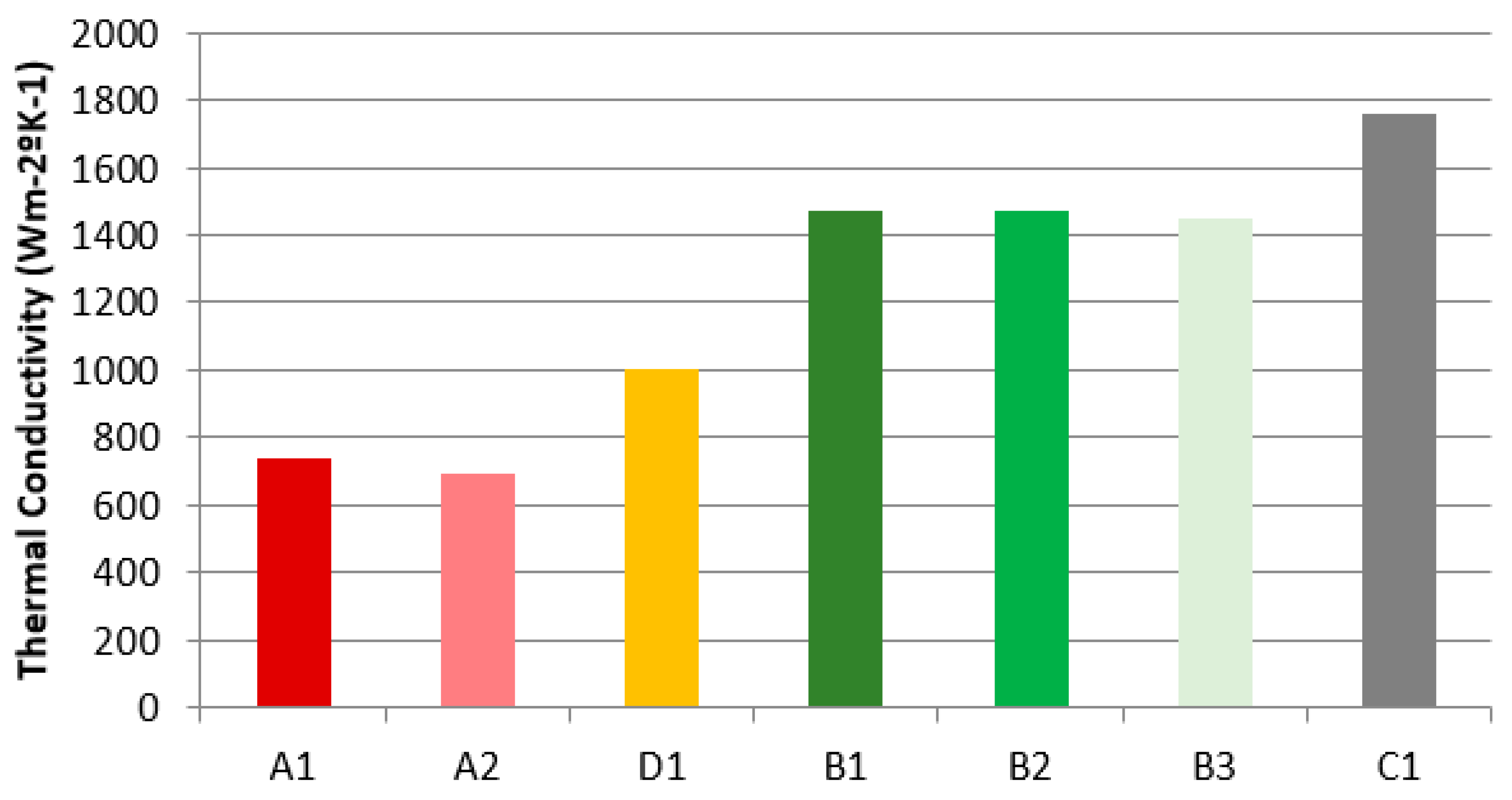

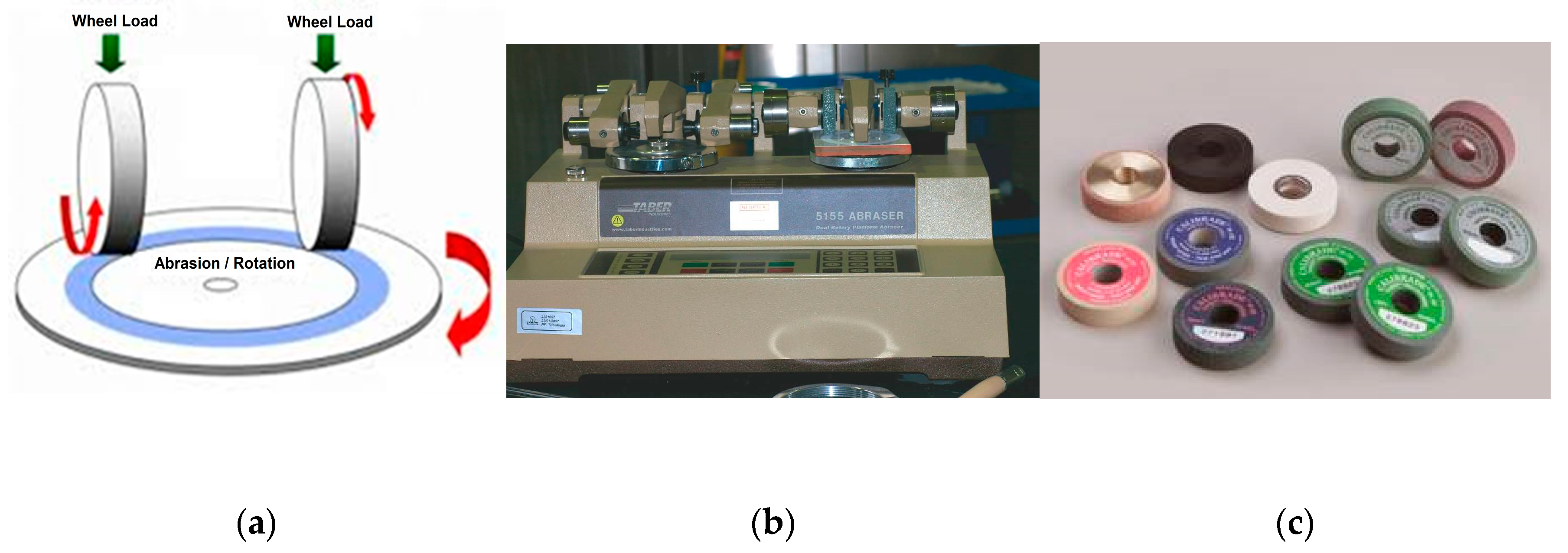




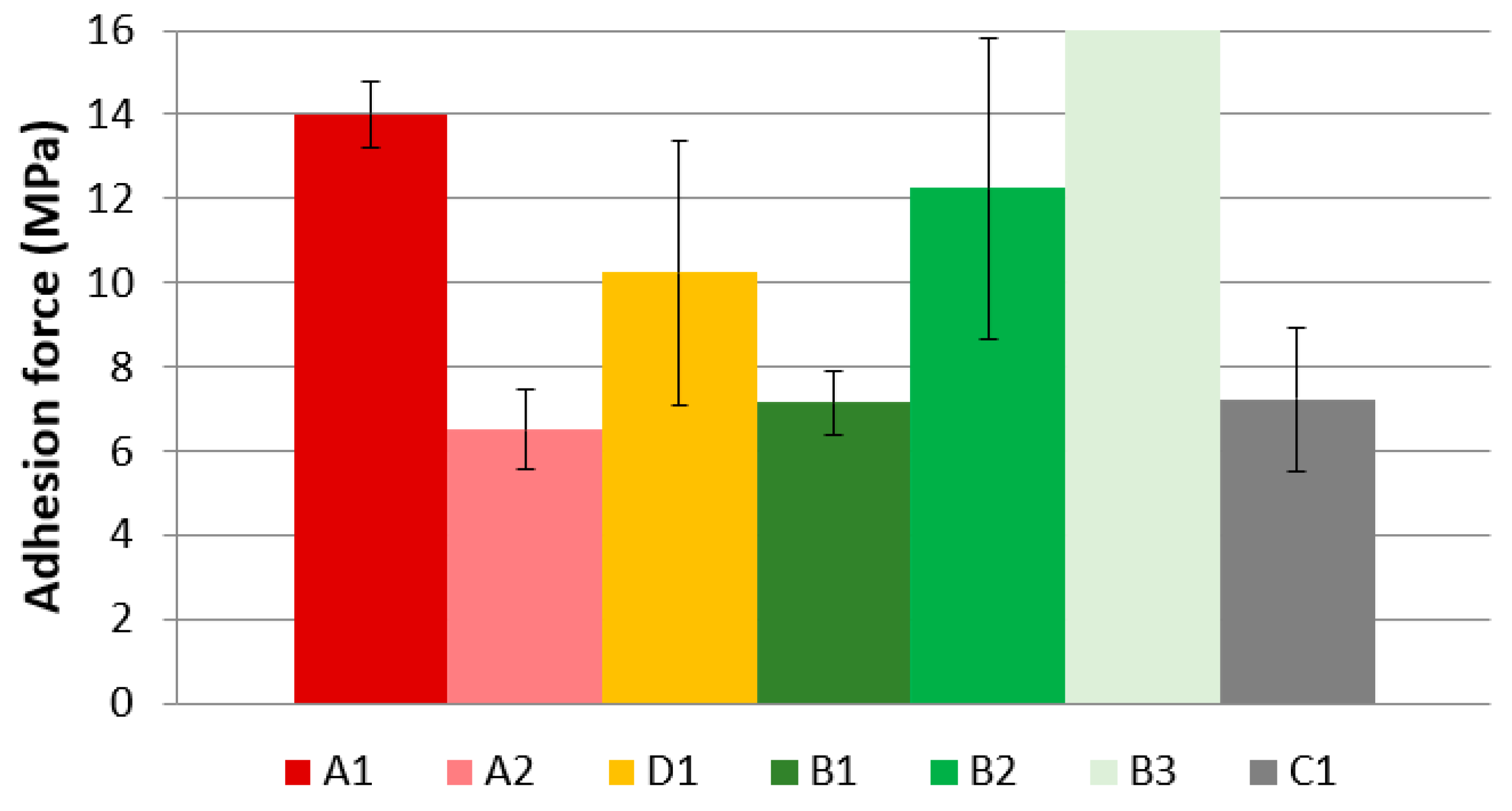

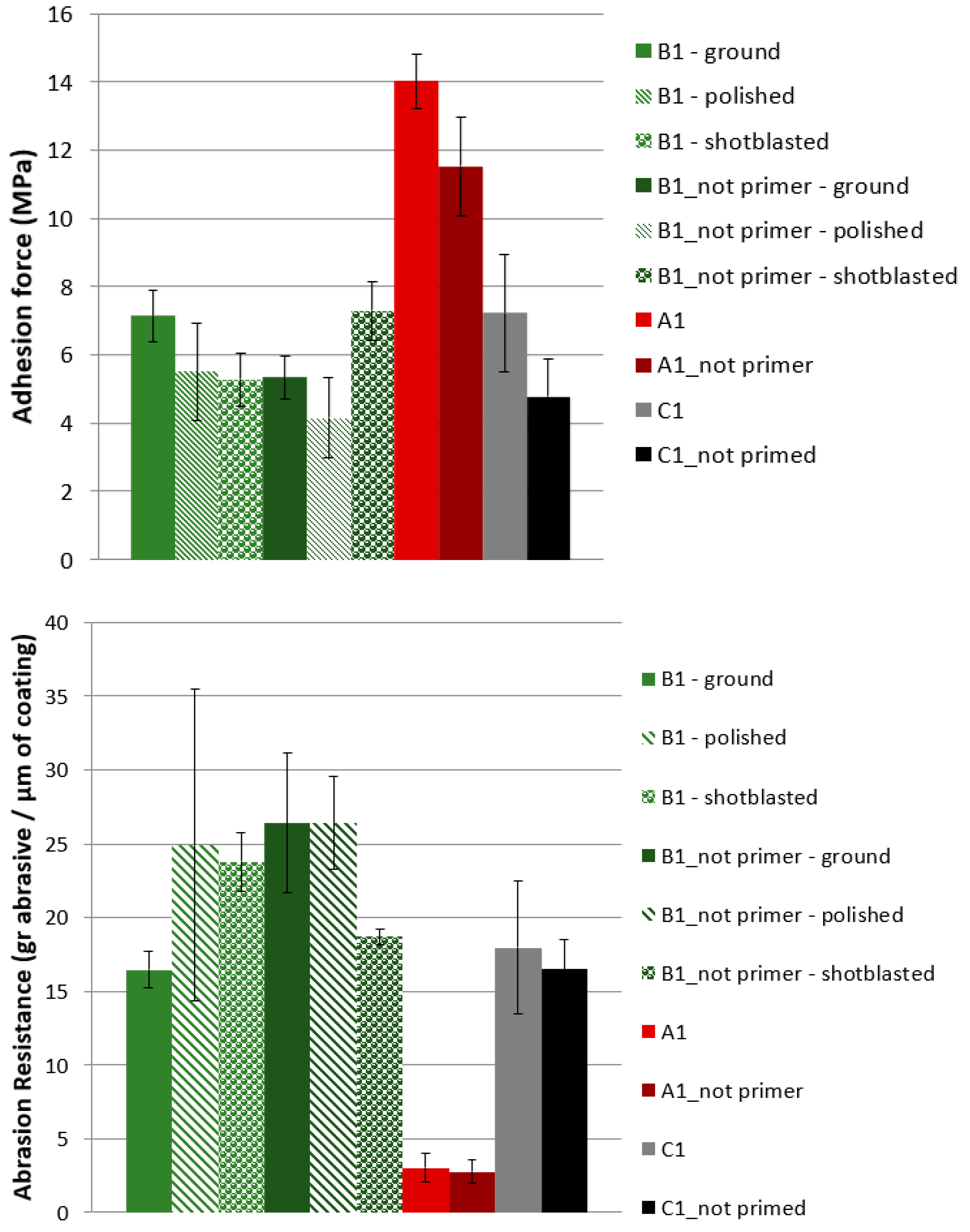
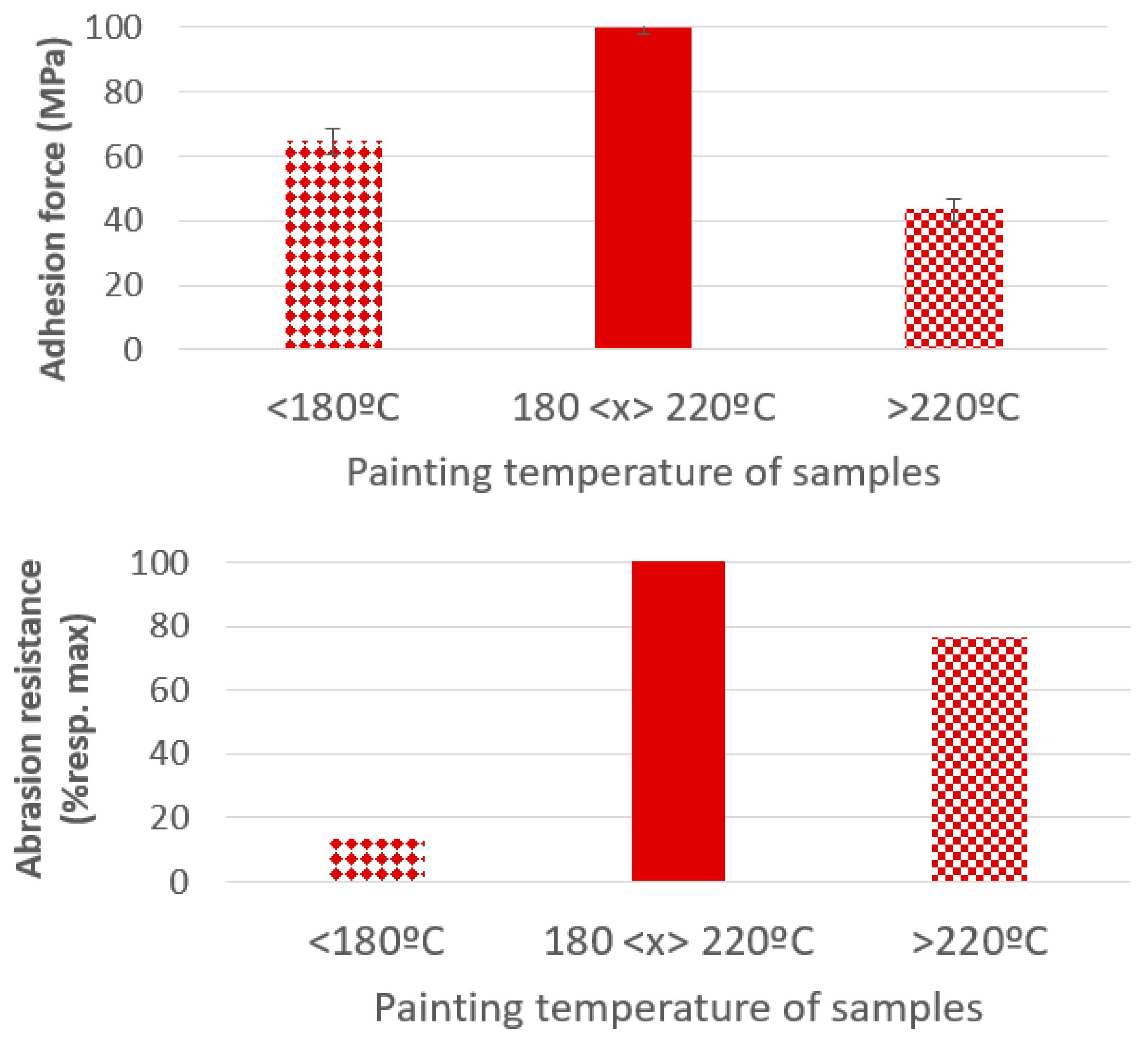
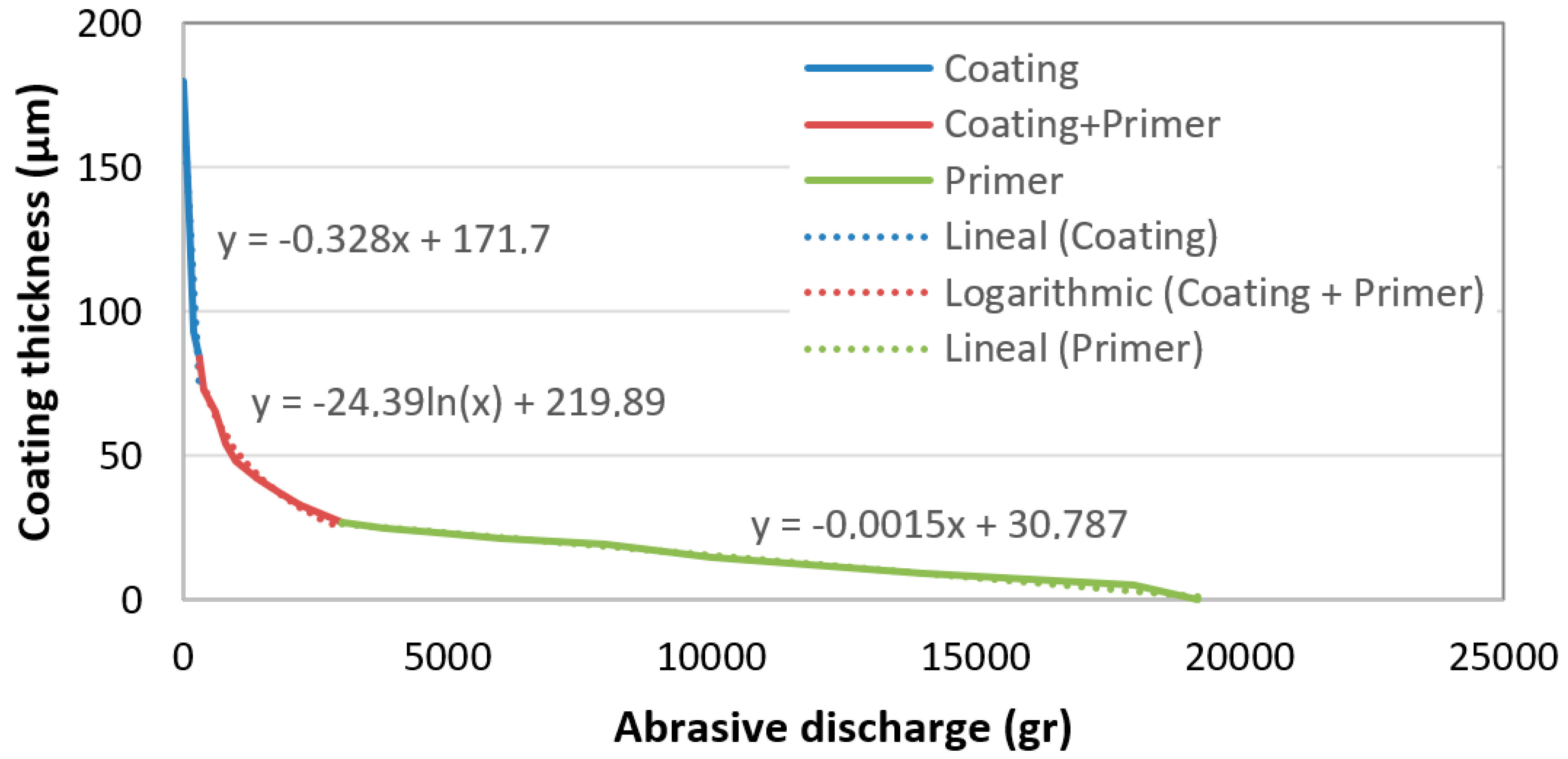
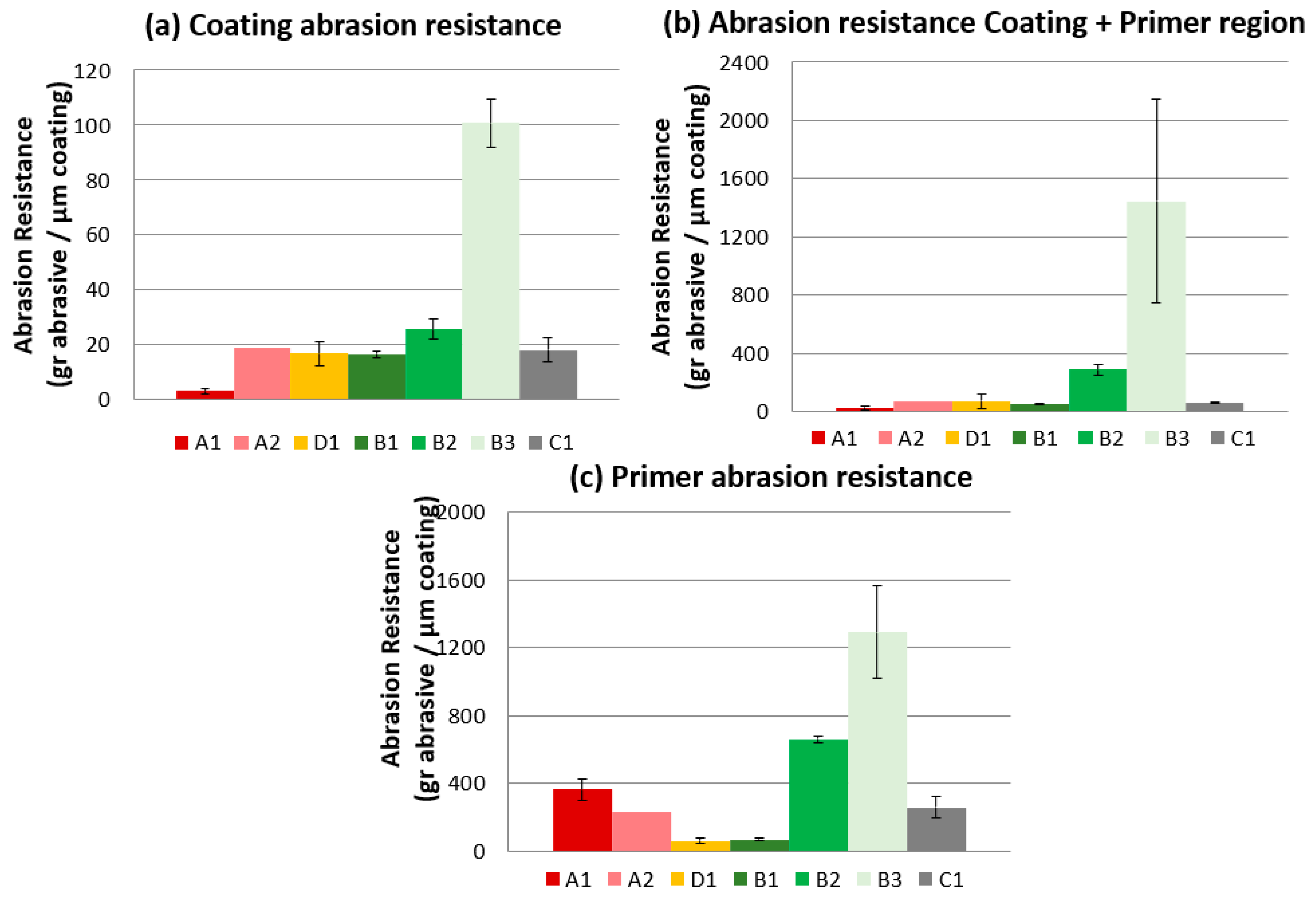


| Hardness (HRC) | Grain Size | Elasticity Modulus (GPa) | Yield Strength (MPa) | Tensile Strength (MPa) | Charpy Impact (J) | |||
|---|---|---|---|---|---|---|---|---|
| 25 °C | 500 °C | 25 °C | 500 °C | 25 °C | 500 °C | |||
| 37–38 | 6 | 210 | 947 | 740 | 1185 | 859 | 113 | 167 |
| Surface Finishing | Roughness Ra (µm) |
|---|---|
| Ground | 1.60 |
| Polished | 0.02 |
| Shot-blasted | 2.81 |
| Name | Description | Nominal Grain Size of Ceramic Particles (µm) | Nominal Thermal Conductivity (Wm−2 K−1), 200 ± 20 µm Layer |
|---|---|---|---|
| P | Primer and function improve the adherence of the painting itself | 25 | 1640 |
| A1 | Very high insulation, very rough finishing, extra binder | 80 | 735 |
| A2 | Very high insulation very rough—new development | 50 | 690 |
| D1 | Medium insulation and extra binder | 30 | 1000 |
| B1 | Average insulation and smooth finishing of final parts | 15 | 1470 |
| B2 | Average insulation, extra binder, smooth finishing of final parts | 15 | 1470 |
| B3 | Average insulation and smooth finishing of final parts—new development | 10 | 1450 |
| C1 | Conductive graphite/release | 35 | 1760 |
| % from Max | Roughness | Adherence | Falling | Taber | Conductivity |
|---|---|---|---|---|---|
| A1 | 100.00 | 81.06 | 3.02 | 0.21 | 41.88 |
| A2 | 57.01 | 40.31 | 18.50 | 4.48 | 39.20 |
| D1 | 67.21 | 57.25 | 16.62 | 3.67 | 56.82 |
| B1 | 40.36 | 37.38 | 21.57 | 1.84 | 83.52 |
| B2 | 38.52 | 62.88 | 25.30 | 3.43 | 83.52 |
| B3 | 28.97 | 100.00 | 100.00 | 100.00 | 82.39 |
| C1 | 39.14 | 45.19 | 15.23 | 1.70 | 100.00 |
| <55% Low >55% High | <40% <50% | <10% <30% | <3% <5% | >70% >50% <50% |
Disclaimer/Publisher’s Note: The statements, opinions and data contained in all publications are solely those of the individual author(s) and contributor(s) and not of MDPI and/or the editor(s). MDPI and/or the editor(s) disclaim responsibility for any injury to people or property resulting from any ideas, methods, instructions or products referred to in the content. |
© 2024 by the authors. Licensee MDPI, Basel, Switzerland. This article is an open access article distributed under the terms and conditions of the Creative Commons Attribution (CC BY) license (https://creativecommons.org/licenses/by/4.0/).
Share and Cite
López-Ortega, A.; Areitioaurtena, O.; Fuentes, E.; Igartua, A.; Merchán, L.; Pardo, E.; Montero, J.; Granado, R.; Martinez de la Pera, I.; Mendizabal, J.; et al. Experimental Evaluation of Ceramic Coatings for Die Protection in Low-Pressure Die-Casting Process. Coatings 2024, 14, 643. https://doi.org/10.3390/coatings14050643
López-Ortega A, Areitioaurtena O, Fuentes E, Igartua A, Merchán L, Pardo E, Montero J, Granado R, Martinez de la Pera I, Mendizabal J, et al. Experimental Evaluation of Ceramic Coatings for Die Protection in Low-Pressure Die-Casting Process. Coatings. 2024; 14(5):643. https://doi.org/10.3390/coatings14050643
Chicago/Turabian StyleLópez-Ortega, Ainara, Olatz Areitioaurtena, Elena Fuentes, Amaya Igartua, Luis Merchán, Enrique Pardo, Jessica Montero, Roberto Granado, Ignacio Martinez de la Pera, Joannes Mendizabal, and et al. 2024. "Experimental Evaluation of Ceramic Coatings for Die Protection in Low-Pressure Die-Casting Process" Coatings 14, no. 5: 643. https://doi.org/10.3390/coatings14050643
APA StyleLópez-Ortega, A., Areitioaurtena, O., Fuentes, E., Igartua, A., Merchán, L., Pardo, E., Montero, J., Granado, R., Martinez de la Pera, I., Mendizabal, J., & Zabala, B. (2024). Experimental Evaluation of Ceramic Coatings for Die Protection in Low-Pressure Die-Casting Process. Coatings, 14(5), 643. https://doi.org/10.3390/coatings14050643








